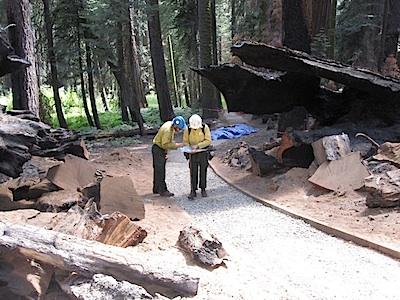A fluke fire burning in the crown of a giant sequoia has prompted the partial closure of the Congress Trail at Sequoia National Park.
The fire is a hold-over from the Circle Meadow Prescribed Fire, conducted last summer to maintain a regular fire cycle that improves forest health by reducing the amount of dead, woody debris that can lead to larger, more intense fires, park fire officials said.
An unusual combination of conditions enabled the fire to smolder through the winter and flare up as the weather became warmer and drier, they said, adding that "the severe drought conditions of the past winter created the dry environment that allowed this fire to continue to burn within the giant sequoia. This is an unprecedented event unknown to have occurred previously in the 45-year history of the parks’ prescribed fire program."
While the fire smolders -- smoke tendrils occasionally waft up from the trunk -- park managers have partially closed a short section of the Congress Trail in the Giant Forest. Park staff are escorting visitors through a short section of the trail. These restrictions are necessary due to the hazard of falling debris from the burning tree, a park release said.
As a result of the flare-up, a short stretch of the Congress Trail is closed between the House Group and the Senate Group of giant sequoias and will remain closed until conditions are safe for visitors. Hikers will be escorted through the Congress Trail segment between the junction of the Alta and Congress trails and the President Tree between 9 a.m. until 6 p.m. During hours outside of this time frame, this stretch of trail will be closed. It will be re-evaluated early next week.
Ninety-five percent of the Congress Trail remains open, and visitors can hike out to the McKinley Tree.
This fire will be closely monitored by park staff. Spot fires from falling embers will be suppressed when safe to do so.
Mature giant sequoias are well-adapted to survive many fires during their long lives. Their thick bark and branches that are elevated far off the ground help to protect them from fire impacts to their trunks and fooliage. Some sequoias will sustain fire impacts due to fuel and forest conditions, drought, and individual tree condition. These impacts may include fire scars at their bases, blackening of portions of their bark, foliage scorch, and structural changes to the tree (loss of tops or limbs).
The loss of portions or all of a giant sequoia to fire or wind storms is part of the process of death and re-birth for these forests.




Add comment